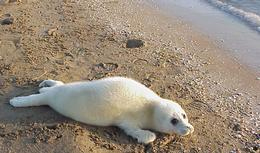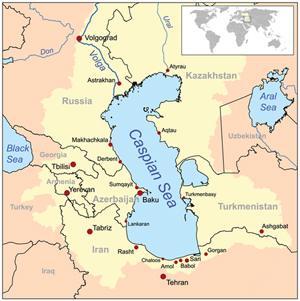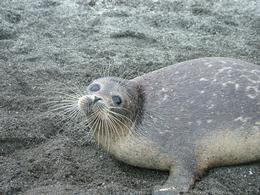Caspian seal numbers plummet 90%
Morgan Erickson-Davis, mongabay.com
November 12, 2008
Caspian Seal populations have declined 90% in the past 100 years, prompting the IUCN to switch their designation from Vulnerable to Endangered.
A team from the University of Leeds performed a series of surveys in 2007 and 2008 which revealed that the birth rate has decreased from around 17,000 pups born per year to only between 6,000 and 7,000 – a drop of 60%. The team's census further showed that the current number of breeding females was only 17,000, a number barely large enough to maintain the genetic viability of the species.
 Newly born seal pup at Ogurchinsky Island, Turkmenistan. Credit: Pavel Erokin, Caspian Seal Conservation Network |
"Each female has just one pup a year, so with numbers at such a low levels, every fertile female that dies is a nail in the coffin of the species." says Dr. Simon Goodman of Leeds' Biological Sciences division. "We're hoping that the seal's change in Red List status will help raise awareness about their plight, and the many important conservation issues facing the whole Caspian ecosystem."
Pollution, habitat degradation, disease, drowning in fishing nets, and commercial hunting have reduced the seal population from over one million at the turn of the 20th century to an estimated 100,000 today. In the Dagestan area of the Russian Federation alone, 8,000 seal pups have been killed in recent years, a number that eclipses the entire species' annual birth rate in an area that has less than seven percent of the Caspian coastline. The team is working on enacting conservation measures that prioritize hunting bans in all countries that border the Caspian Sea.
"Without a suite of conservation measures there is a very high risk the species will become extinct, and possibly within our lifetime," says Dr Goodman. The team is also working on a project funded by the UK Department of Environment, Food and Rural Affairs through the Darwin Initiative that will strengthen the involvement of local scientists in the management of the seals.

Map of the Caspian Sea including a small locator map. The drainage basin of the Caspian Sea is in yellow. The map, which appears on Wikipedia, is based on USGS and Digital Chart of the World data. |
The Caspian Seal is one of only a handful of landlocked seal species and one of the smallest true seals in the world. It is still unclear as to how exactly the seal became landlocked; the currently favored hypothesis describes a migration from the Arctic Ocean approximately 2.5 million years ago. It is thought to have descended from the Ringed Seal.
The Caspian Sea is the world's largest enclosed body of water, itself becoming landlocked around 5.5 million years ago due to continental drift.








